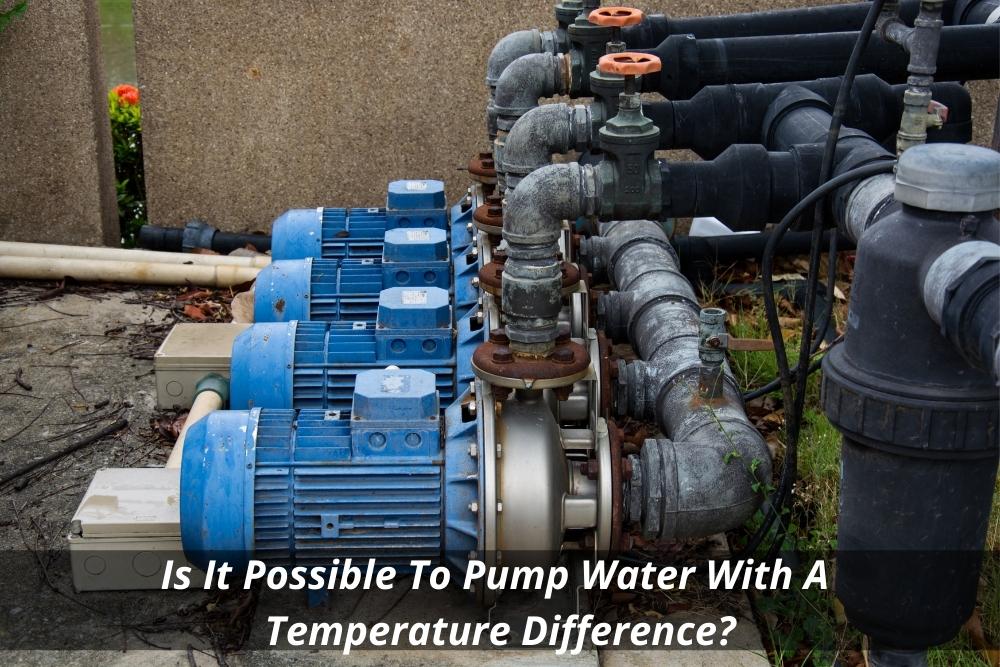Have you ever wondered why some hot water installation looks more relaxed than others? Is it possible to design a hot water installation project so that it appears less complicated?
why some water looks more relaxed than other water? Is it possible to get cold water from hot water heater? If yes, then how does it happen?
Water has always fascinated us since our childhood days. Water is essential for life, and its properties are fascinating. The surface tension of water makes it appear smooth and slippery. This property helps it to float on top of other liquids.
It is possible to pump water using a temperature difference. In order to achieve this, you will require two containers of equal volume.
One container should contain warm water and another container should have cold water. Then, place the warmer container inside the colder container. As soon as the warmer water touches the colder water, it starts flowing out of the colder container.
This phenomenon is because when the warmer water comes in contact with the colder water, they start mixing together. Once the mixture reaches equilibrium, the warmer water flows out of the colder container because there is no longer any pressure gradient between the two containers.
This process can be repeated many times until the desired amount of water is obtained.
How Does Hot Water Work?
Hot water is used for various purposes such as cooking food, washing clothes, bathing, etc. However, we use only a small fraction of the total energy required to heat up water.
In fact, most of the energy goes into converting the chemical potential energy stored in the water molecules into thermal energy. This conversion takes place at the molecular level.
When we boil water, we actually create more heat than what is needed to convert all the available energy stored in the water into thermal energy. This means that if we were able to capture the excess heat created during boiling, we could potentially generate electricity by running an electric generator driven solely by the energy generated during boiling.
The question now arises – how do we make hot water?
There are different methods by which one can produce hot water. They include:
Electric Storage Tank (EST)
A solar-powered storage hot water tank stores solar power in the form of thermal energy. These tanks are made of glass or plastic materials and are placed in direct sunlight. The sun’s rays act like a battery to store electrical energy in the form of heat.
When the sun sets, the temperature of these tanks drops considerably. However, they still hold enough energy to produce hot water even after sunset.
Gas Storage Tanks
These tanks consist of natural gas or propane. They work on the same principle as ESTs. Gas is injected into the tank and heats up the contents of the tank.
Solar Thermal Systems
They utilize solar energy to raise the temperature of the water in a closed loop. Heat collected from the sun is transferred directly to the water.
Compressed Air Energy Storage
Air is compressed and stored in large tanks. After the air expands, the stored energy is released to heat water.
Heat Pumps
Heat pumps transfer thermal energy from one location to another via convection (air).
Hydronic Radiant Heating System
Hydronic radiant heating systems use pipes filled with heated fluid instead of conventional radiators. Most common applications of this technique are found in commercial buildings where hot water heating is produced from the building’s heat exchanger.
Stirling Engine
Stirling engines efficiently convert heat into mechanical motion.
Water Wheel
A water wheel is basically a turbine that converts kinetic energy into useful work.
Conversion of Solar Energy Into Electrical Energy Using PV Cells
PV cells are also called photovoltaic cells. When exposed to light, they generate direct current (DC) within them. This DC voltage is then converted into alternating current (AC) using a transformer. Thus, the output of these cells becomes AC.
You may be wondering why there is no mention of Photovoltaic panels.
Photovoltaic panels have been around for quite some time. However, it was not until recently that people came to realize their importance. Nowadays, almost every home requires at least one photovoltaic panel.
For instance, when most people think about generating electricity, they assume that an array of photovoltaic panels will be installed somewhere close to the house. While this is true, there are many other ways to harness solar power. For example, you can build a photovoltaic cell right on top of your roof!
Using Photovoltaic Cells to Generate Electricity
By connecting several photovoltaic cells together, you can connect them together to form a complete circuit.
If you place all the electrodes facing north and south, you can create a complete circuit. In this case, a complete circuit means that the positive terminal of one cell will be connected to the negative terminal of the next cell. Similarly, the negative terminals of two consecutive cells will be connected to each other.
This creates a potential difference between the two terminals. If you attach a load across this potential difference, you will get electricity.
Thus, a complete circuit has two advantages over a single cell. First, you will need fewer cells to make an electric connection. Second, if any one of the cells fails, the entire circuit will continue to function.
The process is reversed if you want to create a current. In this case, the polarity of the cells should be swapped so that the positive terminal of the first cell is connected to the negative terminal on the last cell.
How do we measure temperature difference?
There are different methods used to find out the temperature difference between the two points. The simplest way is to take a thermometer.
In this approach, you simply insert the thermometer into the container. You let it collect data for 2 minutes or more. Then, you remove the thermometer and compare the reading obtained by inserting the thermometer into both containers.
This method is very easy but it does suffer from some disadvantages. One of which is the fact that the readings recorded on the thermometer might differ slightly depending on how deep the thermometer is inserted into the liquid. Another disadvantage is that once you remove the thermometer, you cannot retrieve its reading.
An alternative method is to use a digital thermometer such as the Thermoworks TC-1000. These devices record data in real-time using a probe. They also allow you to view the recorded values via a display screen.
To make sure that the device works properly, you should calibrate it before starting. Calibration involves placing two probes inside a room where the air temperature is known. Once the device indicates a temperature difference of 50 degrees Celsius, you know that the device is working correctly.
Conclusion
A temperature difference of 5 degrees Celsius is enough to run a small household. But what happens when the difference exceeds 30 degrees Celsius? According to various studies, heat pumps are capable of producing more energy than traditional gas furnaces.
However, these findings are not applicable to everyone. This is because heat pumps operate according to the principle of latent heat transfer. This particular principle requires high input temperatures, usually above 40 degrees Celsius.
But, under certain conditions, you may generate more electricity with a heat pump. For example, if you have a large swimming pool, you can use the sun’s rays to heat up the water to around 85 degrees Celsius.
Once the water reaches this level, you could install a heat exchanger in the pool. Instead of dumping the heated water back into the pool, you could use it to provide cold water to your home.
You could even produce solar power by installing photovoltaic panels on your roof. As long as there is already sufficient sunlight reaching your roof, you can generate plenty of electricity.
If you are interested in studying other energy sources, you may want to read our guide on wind turbines. If you have any questions about this article, feel free to ask us in the comment section below!
What temperature difference will pump water?
In order for a pump to work properly, there must be some form of energy applied to make the water move. Pumps can either use mechanical energy (e.g., a motor), thermal energy (e.g. a boiler), electrical energy (e.g, an electric motor) or hydraulic pressure (e.g., gravity). In most cases, however, a pump uses mechanical energy.
When a pump is operating, the water flows downhill until it meets resistance. The force required to overcome this resistance increases with the speed at which the water moves. When the water reaches the top of the pipe, it falls back down again.
The amount of energy used by a pump depends on several factors including the volume of water being moved; the size of the pump; and the height of the water source.
Pumping water has become increasingly popular over the years. This is mainly due to the rise in global warming. We now live in a world where many people are moving away from using fossil fuels such as natural gas, oil, coal and biomass.
Instead, they are looking for renewable alternatives like solar power, wind power and geothermal power. These alternative energies are considered green because they do not pollute the environment.


